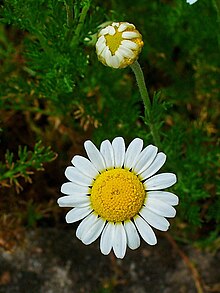Roman chamomile
| Roman chamomile | ||||||||||||
|---|---|---|---|---|---|---|---|---|---|---|---|---|

Roman chamomile ( Chamaemelum nobile ), illustration |
||||||||||||
| Systematics | ||||||||||||
|
||||||||||||
| Scientific name | ||||||||||||
| Chamaemelum nobile | ||||||||||||
| ( L. ) All. |
The Roman chamomile ( Chamaemelum nobile ) is a species of the sunflower (Asteraceae). Like real chamomile, it is used as a medicinal plant.
features
Roman chamomile is a perennial herbaceous plant that smells intensely aromatic. It reaches heights of 15 to 30 cm, is hairy and has branched flower sprouts and short sterile shoots.
The leaves are sessile, have an elongated outline and are two to three times pinnate . The individual sections are linear and pointed.
The flower heads are individually terminal and have long stalks. Their diameter is 18 to 25 mm. The shell of the cup is 4 to 6 mm long and hemispherical. The bracts are in a few rows, are oblong to obovate, hairy when pressed, green, broad and with a translucent skin edge. The bottom of the head is conical and pithy. The chaff leaves are spatulate, blunt and have a green central stripe and a transparent edge.
The ray-florets are female, around 10 mm long and white. Quite often they are also missing. The tubular flowers have a yellow crown with a sloping bulge all around the base. The flowering period is July to October.
The fruits are around 1 to 1.3 mm long, have a rounded cross-section and are smooth and brownish.
The number of chromosomes is 2n = 18.
ingredients
Roman chamomile mainly contains sesquiterpene lactones , mainly nobilin . In addition, flavonoids , (-) - pinene , limonene and bisabolol .
distribution
The species occurs in Western Europe, north to Northern Ireland. Their original range includes the Azores, Morocco, Algeria, Portugal, Spain, France, Great Britain, Ireland and the Channel Islands. In Madeira the species is a neophyte; however, in some other European countries it occurs as inconsistently introduced. In Central Europe, their easternmost occurrences are in Belgium.
Systematics
Synonyms for Chamaemelum nobile (L.) All. are: Anthemis nobilis L. , Ormenis nobilis (L.) J. Gay and Chamomilla nobilis (L.) Godr.
Common names
For the Roman chamomile, the names the very noble Chamill , Gartenkamille ( Switzerland ), Härmelchen ( Meißen ), Kuhmelle ( Franconia ), Romer , Romey and Tramilbenblume are or were, in part only regional, in use.
use
medicine
Roman chamomile is used in Western Europe, particularly France, Belgium and Great Britain, like real chamomile. The flower heads are used, which as a drug (Chamomillae romanae flos) must have a minimum content of essential oils. Areas of application are - again mainly in Western Europe - menstrual cramps and as a carminative for digestive problems. Also for nervousness, hysteria and general weakness. External applications (infusions) are used to rinse wounds, for example in the mouth area for inflammation.
Blonde hair can be lightened with warm infusions.
horticulture
There are two known cultivars of Roman chamomile:
- the non-flowering English lawn chamomile ( Chamaemelum nobile "Treneague").
- the Roman lawn chamomile ( Chamaemelum nobile v. ligulosa, Chamaemelum nobile "Pleno", Chamaemelum nobile "Flore Pleno") with white flowers.
Both are well suited to create a fragrant lawn. Instead of lawn, flat, fragrant herbs like the lawn chamomile are planted. These spread by themselves and form dense cushions.
Both varieties are sterile. Instead, they spread via ground shoots that quickly form roots.
supporting documents
- Siegmund Seybold (Ed.): Schmeil-Fitschen interactive (CD-Rom), Quelle & Meyer, Wiebelsheim 2001/2002, ISBN 3-494-01327-6
Individual evidence
- ↑ a b Erich Oberdorfer : Plant-sociological excursion flora for Germany and neighboring areas . With the collaboration of Angelika Schwabe and Theo Müller. 8th, heavily revised and expanded edition. Eugen Ulmer, Stuttgart (Hohenheim) 2001, ISBN 3-8001-3131-5 , pp. 931-932 .
- ↑ Werner Aberer : Contact allergy and medicinal plants . JDDG, Volume 6, 2008, pp. 15-24. [DOI: 10.1111 / j.1610-0387.2007.06425.x (online)]
- ↑ a b Werner Greuter (2006+): Compositae (pro parte majore). - In: W. Greuter & E. von Raab-Straube (eds.): Compositae. Euro + Med Plantbase - the information resource for Euro-Mediterranean plant diversity. Datasheet Chamaemelum nobile In: Euro + Med Plantbase - the information resource for Euro-Mediterranean plant diversity.
- ^ Georg August Pritzel , Carl Jessen : The German folk names of plants. New contribution to the German linguistic treasure. Philipp Cohen, Hannover 1882, page 31, online.
- ↑ Thomas Schöpke: Römische Kamille , in Medicinal Plant Lexicon , accessed November 17, 2011.
- ↑ Avril Rodway: Herbs and Spices. The most useful plants in nature - culture and use . Tessloff Verlag, Hamburg 1980, ISBN 3-7886-9910-8
- ↑ My beautiful garden
Web links
- Roman chamomile. In: FloraWeb.de.
- Roman chamomile . In: BiolFlor, the database of biological-ecological characteristics of the flora of Germany.
- Profile and distribution map for Bavaria . In: Botanical Information Hub of Bavaria .
- Thomas Meyer: Spornkamille data sheet with identification key and photos at Flora-de: Flora von Deutschland (old name of the website: Flowers in Swabia )




